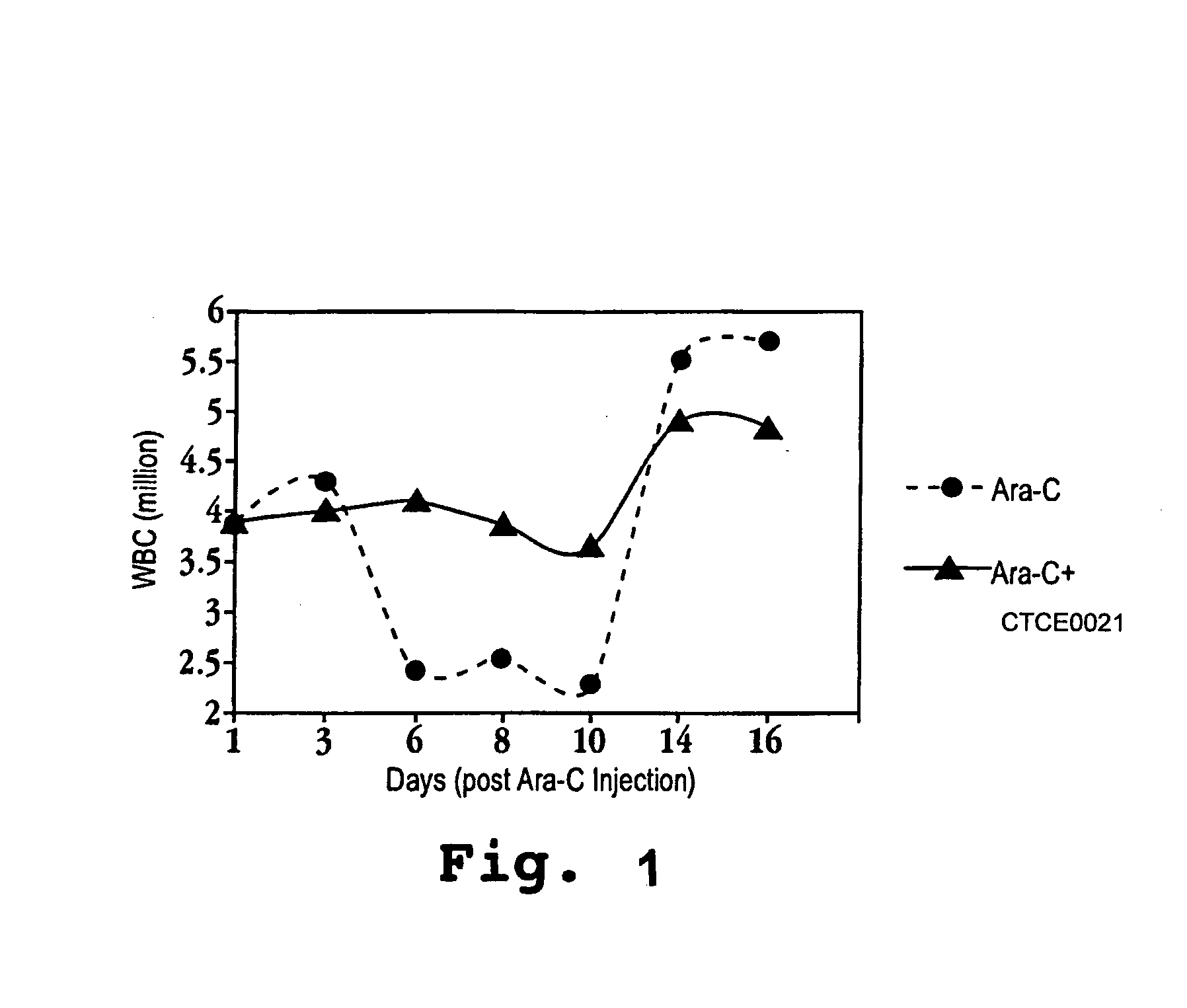CXC chemokine receptor 4 agonist peptides
a technology of chemokine receptor and peptide, which is applied in the field of therapeutic use of chemokine receptor agonists, can solve the problems of increasing the risk of opportunistic infection in patients, and increasing the risk of infection in patients, so as to reduce the susceptibility of cells to cytotoxic agents and reduce the rate of cell multiplication
- Summary
- Abstract
- Description
- Claims
- Application Information
AI Technical Summary
Problems solved by technology
Method used
Image
Examples
example 1
[0107]Peptides of the invention may be synthesized chemically using the Fmoc / tBu strategy on a continuous flow peptide synthesizer, as for example has been carried out using the following protocols:
A) Reagents (Solvents, Support, Chemicals)
[0108]Main Solvent: N,N-Dimethylformamide (DMF): certified ACS spectroanalyzed from Fisher (D131-4) M.W=73.10. The DMF is treated with activated molecular sieves, type 4A (from BDH: B54005) for at least two weeks then tested with FDNB (2,4-Dinitrofluorobenzene from Eastman).
[0109]Procedure: Mix equal volumes of FDNB solution (1 mg / ml in 95% EtOH) and DMF; Let stand 30 minutes; read the absorbance at 381 nm over a FDNB blank (0.5 ml FDNB+0.5 ml 95% EtOH). If the absorbance ˜0.2, the DMF is suitable to be used for the synthesis.
[0110]Deblocking Agent: 20% Piperidine (from Aldrich Chemical company, catalog No: 10,409-4) in DMF containing 0.5% triton X100 v / v (from Sigma, catalg No: T-9284).
[0111]Activating Agents: 2-(H-benzotriazol-lyl) 1,1,3,3-tetra...
example 2
[0159]Tables 1 and 2 show the effect of CXCR4 agonists on bone marrow progenitor cells, particularly primitive erythroide cells and primitive granulocytes, compared to mature granulocytes. To obtain the data in Tables 1 and 2, cells were pre-incubated with each of the compounds or saline alone (‘no drug’ as control). The cells were then exposed to high dose H3-thymidine, a cytotoxic agent. Rapidly dividing cells accumulate proportionally more of the cytotoxic radioactive thymidine and as a result are preferentially killed. The relative proportion of cells killed by the thymidine treatment compared to the control is indicative of the relative effectiveness of the compounds in reducing cellular multiplication, i.e. decreasing the rate of cell cycle progression. A higher (or unchanged) proportion of killed cells compared to the control is indicative that a compound does not reduce cellular multiplication of the given cell type.
[0160]
TABLE 1Effect of CXCR4 Agonists on Bone Marrow Progen...
example 3
[0164]The present example demonstrates the therapeutic effectiveness of CXCR4 agonists in an animal model, showing protection of hematopoietic cells from cytotoxic treatments with CXCR4 agonists. In these animal studies, normal mice were treated with the cytotoxic chemotherapeutic agent arabinose-cytosine (Ara-C), which are known to deleteriously affect cells with high rates of DNA synthesis (reflecting rapid cell cycling).
[0165]As shown in the graph of FIG. 1, in mice given a single dose of Arabinose Cytosine (Ara-C) at 350 mg / kg at day zero intravenously, white blood cell count (WBC) decreases (due to the cytotoxic action of Ara-C). In contrast, in mice given the peptide SDF-1(1-14)-(G)4-SDF-1(55-67)-K20 / E24-cyclic amide (SEQ ID NO:23) (designated CTC in the graph legend) in combination with Ara-C, the extent of white blood cell count decrease is significantly ameliorated. In the graph, circular data points correspond to the white blood cell count in animals that received Ara-C bu...
PUM
| Property | Measurement | Unit |
|---|---|---|
| plasma half life | aaaaa | aaaaa |
| plasma half life | aaaaa | aaaaa |
| plasma half life | aaaaa | aaaaa |
Abstract
Description
Claims
Application Information
 Login to View More
Login to View More - R&D
- Intellectual Property
- Life Sciences
- Materials
- Tech Scout
- Unparalleled Data Quality
- Higher Quality Content
- 60% Fewer Hallucinations
Browse by: Latest US Patents, China's latest patents, Technical Efficacy Thesaurus, Application Domain, Technology Topic, Popular Technical Reports.
© 2025 PatSnap. All rights reserved.Legal|Privacy policy|Modern Slavery Act Transparency Statement|Sitemap|About US| Contact US: help@patsnap.com



